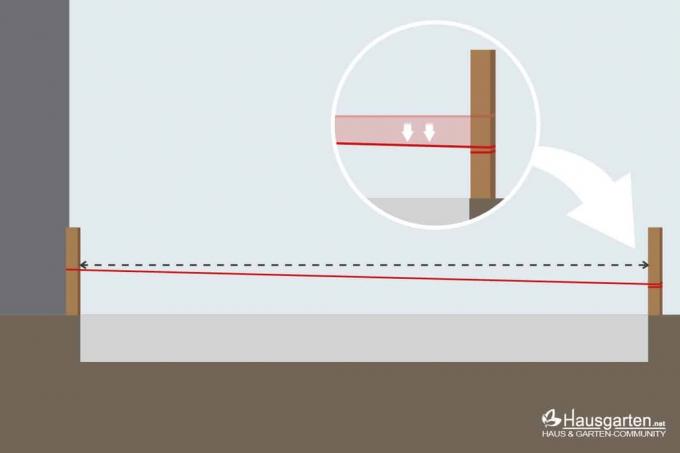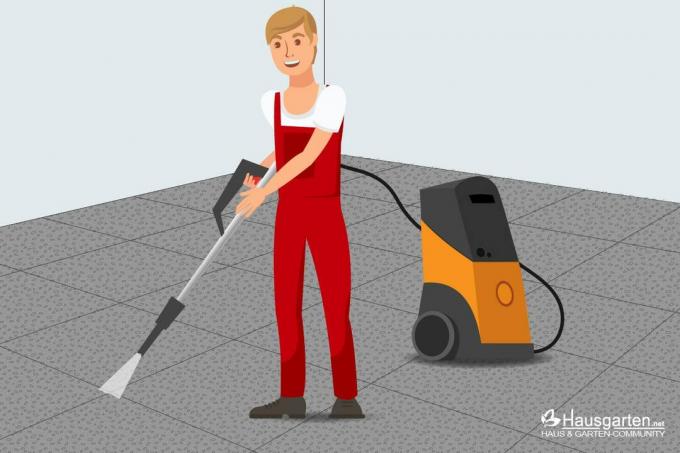

Table of contents
- Preparation
- stone and ceramic tiles
- wooden tiles
- Click tiles made of wood and plastic
- post-treatment
Cleaning patio tiles is actually quite easy. However, means and methods should be tailored to the material so that the tiles are thoroughly cleaned without damaging the material. For example, wood needs to be treated differently than stone or ceramic tiles. Interested readers can find out here whether high-pressure cleaners or scrubbers are the right choice for cleaning tiles in the garden.
Preparation
Regardless of whether the terrace tiles are made of wood or stone, the terrace must be prepared accordingly before thorough cleaning. This includes the following points:
- Clear the terrace
- Remove coarse dirt such as leaves, branches and twigs
- Remove weeds from the joints with a joint scraper
- Pre-treat green coverings such as moss and lichen
- Check tiles for damage and weak points
Soda has proven itself for the pre-treatment of moss and lichen. Ideally, washing soda is used directly. Dissolved in water, it is applied generously to the affected areas and left on for about an hour. The tiles can then be scrubbed and rinsed.
stone and ceramic tiles
Stone and ceramic patio tiles are fairly easy to clean. They can be cleaned very easily with a high-pressure cleaner and pure water. However, cracks in the tiles and cracks in the joints can cause problems when cleaning with high pressure. The water can increase the damage. It is therefore important, as mentioned, to check the tiles in advance.
Damaged areas should be cleaned by hand and without high pressure and then repaired. In the case of very heavy soiling, it can also help to pretreat the patio tiles with soft soap or washing-up liquid before using the high-pressure cleaner. This loosens the dirt and makes it easier to remove afterwards.
Tip:
If you only use the high-pressure cleaner for cleaning the terrace, you do not have to buy such a device yourself. Many hardware stores also rent them for a small fee.
wooden tiles

Wooden terrace tiles are more sensitive to targeted and selective pressure. Unnoticed cracks in the wood can cause individual parts to come off during high-pressure cleaning. Connection points and wood glue can come loose. It is therefore not recommended to use a high-pressure cleaner.
The easy way is to clean with soft soap, water and a scrubbing brush. A hand brush can also be used for tighter areas. As simple as this method is, it is also very tiring. An alternative to this is an electric scrubber. With this and a pre-treatment with soda or soft soap, the cleaning of the wooden tiles is much easier and the effort is reduced.
Click tiles made of wood and plastic
Terrace tiles with a plastic click system and a wooden or plastic overlay have many advantages. They are comparatively inexpensive, can be laid quickly and easily and, if necessary, removed from the terrace or balcony just as easily and quickly. If necessary, individual tiles can also be replaced.
Advantage
When cleaning the terrace with click tiles, these properties and the combination of materials result in both advantages and disadvantages. On the one hand, large amounts of dirt accumulate in the joints and under the tiles. Experience has shown that leaves, soil, pebbles and dead plant parts appear in large quantities when the click tiles are removed. For a really thorough pre-cleaning, it is therefore not enough to sweep the terrace tiles. The joints should be vacuumed. It is even more thorough and cleaner if the tiles are clicked apart directly and the subsurface is cleaned separately.
Disadvantage
On the other hand, the click system made of plastic becomes brittle and brittle over time, which could cause damage when subjected to high-pressure cleaning. The same applies to the comparatively thin wooden slats that are screwed onto the plastic. While these are resilient under distributed pressure, they can crack and tear under targeted high pressure.
Clean
It is therefore better to clean the click tiles on the terrace or balcony as follows:
- The tiles are separated from each other and already roughly cleaned of dirt.
- The surface is freed from coarse dirt, such as leaves, twigs and soil, with a broom. It can then be cleaned with a scrubber or a high-pressure cleaner.
- The click tiles themselves are first brushed dry. A bottle brush of appropriate thickness is recommended for grooves and joints.
- Once all dry and coarse dirt has been removed, the tiles can be brushed or scrubbed wet. A mixture of soft soap, dissolved washing soda or washing-up liquid and water is recommended as a cleaning solution.
- To prevent the terrace tiles from becoming stained by the cleaning agent, they should then be rinsed off well with clear water.
- The tiles can be set up to dry or laid out again directly.
post-treatment

Wood preservatives can be used on tiles made of wood, which protect the natural material from penetrating moisture and prevent the resulting frost damage, reduce the risk of cracks and also warping and bending of the wood prevent.
 garden editorial
garden editorial I write about everything that interests me in my garden.
Learn more about building a terrace

Effectively remove lichen from paving stones
A covering of lichen on paving stones not only looks ugly, but also poses the risk of slipping. With the following tips, you can easily and effectively remove unloved roommates from your patio and garden paths.

Distance between decking boards | Information on terrace construction
A correct distance between the terrace boards and the substructure determines the longevity of a terrace. Only well-ventilated wood dries out optimally to prevent the formation of mold and rot. Last but not least, the movement tolerance plays another decisive role.

Lichen: remove white spots on paving stones
In addition to mosses, yellow-white coverings often adorn the paving stones of our driveways. It is not uncommon for dull stains to spoil the joy of the new stones shortly after they have been laid. Although sometimes wrongly dismissed as an indication of poor material quality, this is actually a natural phenomenon.

Determine the gradient on a terrace: this is how it works
Rain, snow or ice, depending on the weather, water collects on the patio floor. The terrace needs a slope so that no annoying puddles form on it. Calculating the slope is easy once you know the length and material of the decking.

Terrace construction: the 1×1 of the substructure
When constructing a terrace, the substructure plays a decisive role in determining the service life. However, it must also be tailored to the respective material and the substrate. Here you can find out what to look out for.

Laying a wooden terrace on exposed concrete slabs: this is how it works
A wooden deck is warm and natural, welcoming and cosy. But what if you already have a terrace made of exposed aggregate concrete? This is not a problem but an advantage. Because this can be used directly as a basis. We show how.
